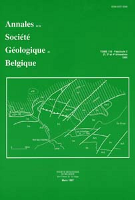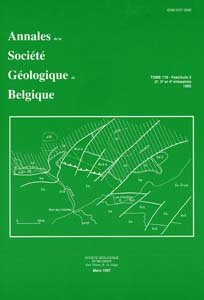- Accueil
- Publications spéciales = special publications
- Géologie des domaines cristallins - Centenaire de ...
- Some aspects of the evolution of the St-Malo migmatite belt, Armorican Massif, France
Visualisation(s): 1306 (34 ULiège)
Téléchargement(s): 272 (1 ULiège)
Some aspects of the evolution of the St-Malo migmatite belt, Armorican Massif, France

Abstract
The Armorican Massif of north-west France is composed of three geological units: a variety of Precambrian rocks which formed the basement to the Hercynian Orogen; a sequence of Palaeozoic rocks which lie within narrow elongate synclinal belts; and a variety of granitic complexes of late-Precambrian to Carboniferous age. The Precambrian of the Armorican Massif is divided into two fundamental tectonic units—the Pentevrian and the Brioverian. The Pentevrian is a basement unit older than about 900 m.yr. which comprises metasediments, migmatites, paragneisses and orthogneisses often with a complex history of multiple deformation and metamorphism (Roach et al., 1972). The Brioverian is a cover unit of sediments and volcanics laid down on the Pentevrian basement sometime during the interval 900-700 or 650 m.yr. (Roach et al., 1972 and Bishop, Roach and Adams, in press). Both the Pentevrian basement unit and the Brioverian cover unit were affected by the late-Precambrian Cadomian orogenic episode. The Precambrian rocks in the northern part of the Armorican Massif have escaped strong regeneration during the Hercynian orogenic episode.
The St. Malo migmatite belt is located along the north Brittany coast between the towns of N. D. du Guildo (Côtes-du-Nord) and Cancale (Ille-et-Vilaine). The belt, which has a north-east trend and structural grain, has been assigned to the Hercynian (Abrard, 1923), Caledonian (Graindor, 1962) and Cadomian (Leutwein, 1968 and Jeannette, 1971) earth movements. Detailed structural and metamorphic studies have shown, however, that rocks within the St. Malo migmatite belt have a longer structural history and a higher metamorphic grade than adjacent Brioverian supracrustal rocks (Brown et al., 1971). Up to four episodes of deformation have affected rocks within the migmatite belt before cataclasis within shear belts of Cadomian age. The St. Malo migmatite belt represents part of the Pentevrian basement unit within the Precambrian of the Armorican Massif.
Included within the St. Malo migmatite belt are metasediments, metatexites, diatexites and, locally, sheets of granite and trondhjemite. The terms metatexite and diatexite are used according to the definitions proposed by Brown (1973). Metatexis is defined as "... the process of segregation (usually of quartz and feldspar) by metamorphic differentiation and partial fusion" and a metatexite is therefore a rock "... produced by metatexis and in which the migmatitic banding is evident." Diatexis is defined as "... high-grade anatexis in which fusion may be complete" and a diatexite is therefore a rock "... produced by diatexis and in which there is no continuous migmatitic banding." The western half of the St. Malo migmatite belt comprises approximately equal proportions of metatexite and diatexite at the presently exposed level. Mesoscopic patches of diatexite are common within the metatexite and often fragment the metatexite to give a schollen structure. Granite sheets are common within the metatexites. The eastern half of the St. Malo migmatite belt is dominated by diatexite at the level now exposed. The diatexite forms a core to the migmatite belt and on its south-eastern side has punched through the metatexite envelope to intrude Pentevrian metasediments. The River Rance provides a transverse section through the St. Malo migmatite belt (Cogné, 1951) and allows the transition from Pentevrian metasediment to metatexite to diatexite to be studied in detail.
Both inhomogeneous diatexites, with schlieren of biotite or biotite + sillimanite (schlieren structure), and homogeneous diatexites, without schlieren of biotite (nebulitic structure), are present within the St. Malo belt. The diatexite mineral assemblage is quartz, plagioclase (of variable composition within the oligoclase range), microcline (often microcline micro-perthite), biotite and muscovite. The microcline embays the plagioclase in a manner suggesting a late and replacive origin. The muscovite is generally intergrown with quartz in a symplectite. There are minor amounts of sillimanite, zircon, apatite and magnetite and rare dravite. Textures within the diatexites are consistent with crystal-liquid equilibria.
The major element chemistry of the Pentevrian metasediments is similar to that of calcium-poor greywacke. The major element chemistry of the diatexites shows a closer affinity with sediments of greywacke type rather than with sediments of arkose type. The diatexites have K/Rb ratios near the average for upper crustal rocks (inhomogeneous diatexite 221 and homogeneous diatexite 224) and Th/U ratios similar to amphibolite facies granite gneisses (inhomogeneous diatexite 6.2 and homogeneous diatexite 5.9). Mesonormative Q-Ab-Or ratios of the diatexites show a close relationship with points of minimum melt composition determined experimentally within the NaAlSi3O8-KAlSi3O8-CaAl2Si2O8-SiO2-H2O system and projected from An onto the Q-Ab-Or face of the Q-Ab-Or-An tetrahedron. Mesonormative Ab-Or-An ratios of the diatexites lie within the plagioclase feldspar field on the ternary feldspar face of the Q-Ab-Or-An tetrahedron. A variety of evidence suggests that the diatexites crystallized under variable water vapour pressures in the range 2-5 kbs. Consideration of the water saturated phase relations in the Q-Ab-Or-An tetrahedron shows that the mesonormative compositions of the diatexites lie across the quartz-feldspar surface either in the primary phase volume of quartz or in the primary phase volume of plagioclase feldspar. Crystallization of the diatexites would have proceeded with the early appearance of quartz and plagioclase feldspar which would have moved the liquid composition down the quartz-feldspar surface to the intersection with the two feldspar surface when K-feldspar would have appeared. This is consistent with the observed textural relationships between the felsic phases. P-T conditions were within the stability field of sillimanite and probably above the stability of muscovite (breakdown possibly by the vapour absent reaction plagioclase + muscovite + quartz = sillimanite + K-feldspar + liquid) at the level now exposed and probably above the stability of biotite (breakdown possibly by the vapour absent reaction biotite + sillimanite + quartz = cordierite + K-feldspar + liquid) at deeper levels within the belt.






